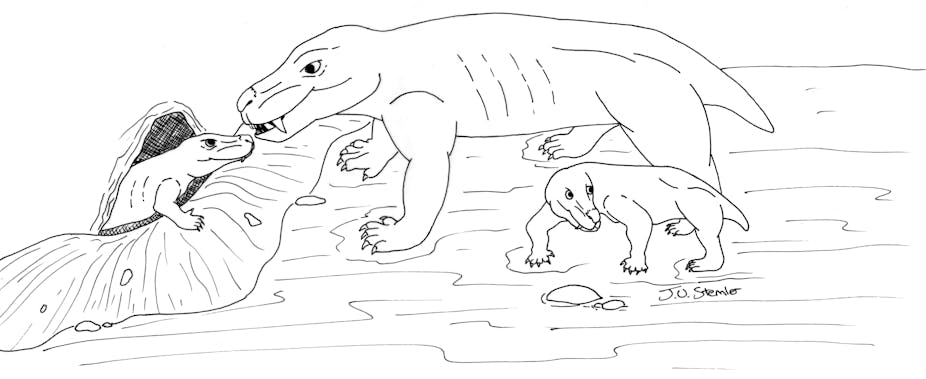We all know that mammals protect and care for their young. In some cases, they also live within complex social groups. Was this always the case?
The skeletal anatomy of mammals’ early ancestors has been studied for more than 150 years. But until relatively recently, not much was known about their lifestyle or reproductive habits. It wasn’t clear whether these extinct animals protected and cared for their young in the same way as modern mammals do.
But a few decades ago a clue to their behaviour was discovered in two remarkable fossils found in South Africa that date back 251 million years ago. The significance of these fossils of Thrinaxodon liorhinus and Galesaurus planiceps have been largely forgotten by the palaeontological community and they were left out of recent discussions about parental care in the fossil record. We rediscovered them while doing other research and decided to reinvestigate their significance.
The fossils are even more important than we imagined. They provide direct evidence of parental care in these extinct animals. They also reveal complex behaviour in our own distant ancestors.
The first discoveries
The Thrinaxodon and Galesaurus fossils date back to the Early Triassic period, soon after the end-Permian mass extinction and before the age of dinosaurs.
Mammals hadn’t yet evolved. But their ancestors, the non-mammalian cynodonts, had a few features we recognise today in mammals: teeth differentiated into incisors, canines and complex postcanines, and the presence of a secondary palate. The fossils of Thrinaxodon and Galesaurus represented the first possible cases of parental care reported in non-mammalian cynodonts. This is significant because mammals didn’t evolve for another 30 million years.
The Thrinaxodon fossil was found in 1954 by the renowned Karoo fossil hunter James Kitching. Dr. A.S. Brink, a palaeontologist at Johannesburg’s University of the Witwatersrand, briefly described it as consisting of an adult skull preserved next to a small juvenile about a third of its size. Brink hypothesised that this represented a case of parental care.
In 1965 Brink discovered a second case of parental care in Galesaurus planiceps, a larger basal cynodont about the size of a fox. The Galesaurus fossil block contained the skeleton of an adult surrounded by juveniles. Brink interpreted this fossil as evidence of a mother caring for her young.
These remarkable fossils became part of the collection of the Evolutionary Studies Institute at the University of the Witwatersrand. We came across them while investigating ontogenetic growth in Thrinaxodon and Galesaurus. We wanted to find out how these cynodonts’ skull changed as they grew from a small juvenile into a large adult. In the course of our work, we realised that these fossils were also telling a forgotten story about nurturing behaviour in our very distant ancestors.
Some further work had been done on the Thrinaxodon fossil since Brink’s 1955 description. The skulls are now separated from each other and acid-preparation led to the discovery of a second juvenile individual. But the Galesaurus fossil was found tucked away in a drawer in collections, with no evidence of further preparation or study.
We were intrigued, and decided to reinvestigate what the fossils might tell us about parental care among the ancestors of mammals.
Our findings
Our study concluded that in both cases there were two young juveniles associated with each adult.

We then investigated more than 100 fossils of Thrinaxodon and Galesaurus from South Africa to determine how often individuals of each genus were preserved together. The bones of individuals that were found together in the same fossil block or in close proximity were, in many cases, preserved in “life position”.
This suggests that these animals were living together in a group – what’s known as an aggregation – before they died and were fossilised.
The research we’d already done into ontogenetic classification really helped. We had sorted the Thrinaxodon and Galesaurus specimens into juvenile, subadult, or adult stages. This meant we could determine whether the aggregation consisted of individuals of the same age – for example, all adults – or represented a mixed-age group, such as an adult with juveniles.
Overall, we found that Thrinaxodon had a higher occurrence of aggregations than Galesaurus. These groups were comprised of individuals of either similar or different ontogenetic ages.

In Thrinaxodon, we found four aggregations consisting of same-age individuals and three aggregations among mixed-age individuals – including the parental care case described by Brink. This is in stark contrast to Galesaurus: here, only one other aggregation, among three sub-adult individuals, was found in addition to the parental care case. These findings suggest that Thrinaxodon regularly lived within a group.
The two parental care fossils Brink described showed the largest discrepancy in size among aggregating individuals. This implies he was right: these fossils do indeed represent cases of parental care.
The juveniles in each parental care fossil represent the smallest recorded individuals for both genera, suggesting they were newborns. In addition, the juveniles of each genus are similar in size to each other. That indicates they might have been siblings. We also confirmed that the adult Galesaurus individual represented a “female” – so, a mother – based on our previous discovery of sexual dimorphism in this genus.
Parenting in the past
Parental care was present in both of these cynodonts, but the evidence to date suggests that Galesaurus cared for its young for a relatively longer period of time. This is because the skull of the Galesaurus juveniles is about half the size of the largest known adult, and it is relatively much larger than the Thrinaxodon juveniles. This discrepancy in size also supports our previous idea that Thrinaxodon matured relatively earlier than Galesaurus.
What these fossils show is that parental care instincts were already established 251 million years ago in two different species of mammal forerunners. This indicates that complex behaviour generally attributed to living mammals has a long history, stretching back millions of years.

